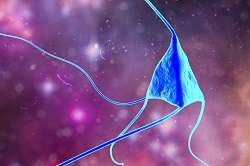Mapping the brain's cortical columns to develop innovative brain-computer interfaces

The EU-funded COLUMNARCODECRACKING project has successfully used ultra-high fMRI scanners to map cortical columns, a process that opens the door to exciting new applications, such as brain-computer interfaces.
Cortical columnar-level fMRI has already contributed and will further contribute to a deeper understanding of how the brain and mind work by zooming into the fine-grained functional organisation within specialised brain areas.
By focussing on this, the project has stimulated a new research line of 'mesoscopic' brain imaging that is gaining increasing momentum in the field of human cognitive and computational neuroscience. This new field complements conventional macroscopic brain imaging that measures activity in brain areas and large-scale networks.
Measuring cortical columns
Cortical columns are a group of neurons in the brain that run from the top to the bottom of cortex and respond to the same stimulus property. For example, primary visual cortex columns extract small bars with a specific orientation, which are elementary features for analysing the shape of objects.
A single cortical column contains thousands or even tens of thousands of neurons corresponding to a few tens of micrometers and up to 1-2 millimetres for larger aggregated columnar structures.
'It has been extremely difficult though to reliably measure cortical columns with non-invasive functional brain imaging in humans, but COLUMNARCODECRACKING has made substantial advances in this,' Prof. Dr Goebel explained. 'We've pushed the limits of technology and have developed new paradigms, analysis methods and modelling tools... We've achieved a sub-millimetre range of spatial resolution that allows us to 'see' larger columns but we still need to increase resolution further to capture more fine-grained columnar organisations.' After using 7 Tesla MRI, the project has started to do this with one of the few 9.4 Tesla scanners in the world.
Powerful brain-computer interfaces
One of the most promising applications that could result from the project's research is the creation of novel powerful brain-computer interfaces (BCIs), using ultra-high field (UHF) fMRI measurements. 'On the one hand, this provides a challenging test bed for our newly acquired knowledge about coding principles in brain areas. On the other hand this research could lead to novel applications for some patients, such as those suffering locked-in syndrome, despite the limited availability of UHF scanners,' said Prof. Dr. Goebel.
The project has conducted several 7 Tesla fMRI studies to test whether it is possible to create BCIs that exploit information at the level of columnar-level features. 'This is extremely challenging because we do not focus on brain activity from external stimulation but we investigate brain activity patterns as a result of a participant's imagination, i.e. From self-stimulated brain activity,' explained Prof. Dr. Goebel. 'We have asked participants to imagine a field of dots moving in different directions. With 7 Tesla fMRI, we could then indeed decode from the generated brain activity in the visual cortex which direction of motion a subject has imagined without showing any external visual stimulus.'
This is exciting as it indicates for the first time that feature-level information (in this example, different directions of imagined motion) can indeed be used to build fMRI-based UHF BCIs. However, Prof. Dr. Goebel acknowledges that some improvements are required in order to increase the decoding accuracy before the system can be tested on actual patients.
In one current study, the project team is testing whether it is possible to build high-resolution BCIs at 7 Tesla that allow subjects to write letters of the alphabet simply by imagining how the letters look. This is challenging as it requires disentangling brain activity that largely overlaps in the same early visual brain areas. The first results with four different letters are promising but it is not yet clear whether this direct letter imagery BCI will reach high accuracies when using all letters of the alphabet.
Future research efforts
Whilst the project has produced exciting results, Prof. Dr. Goebel emphasises that there is still much research to be undertaken. Whilst the project has mapped the columnar organisation in a few specialised brain areas, there are at least 30 mid-level visual, auditory, somatosensory and multisensory areas where the detailed columnar-level feature representations remain unknown. One example of this is the currently unknown features used by the visual word form area, a region that is active during reading.
'I hope that my current and future research will lead to a deeper understanding of how visual perception and cognition emerge from feature representations and their interactions in the brain,' Prof. Dr. Goebel stated. Such a deeper understanding could indeed pave the way for highly advanced BCIs that could not only help treat neurological disorders but also significantly upgrade humankind's ability to integrate and connect organically with high-powered computer systems.
More information: cordis.europa.eu/project/rcn/98761_en.htmlFor more information please see the COLUMNARCODECRACKING CORDIS page:
Provided by CORDIS




















